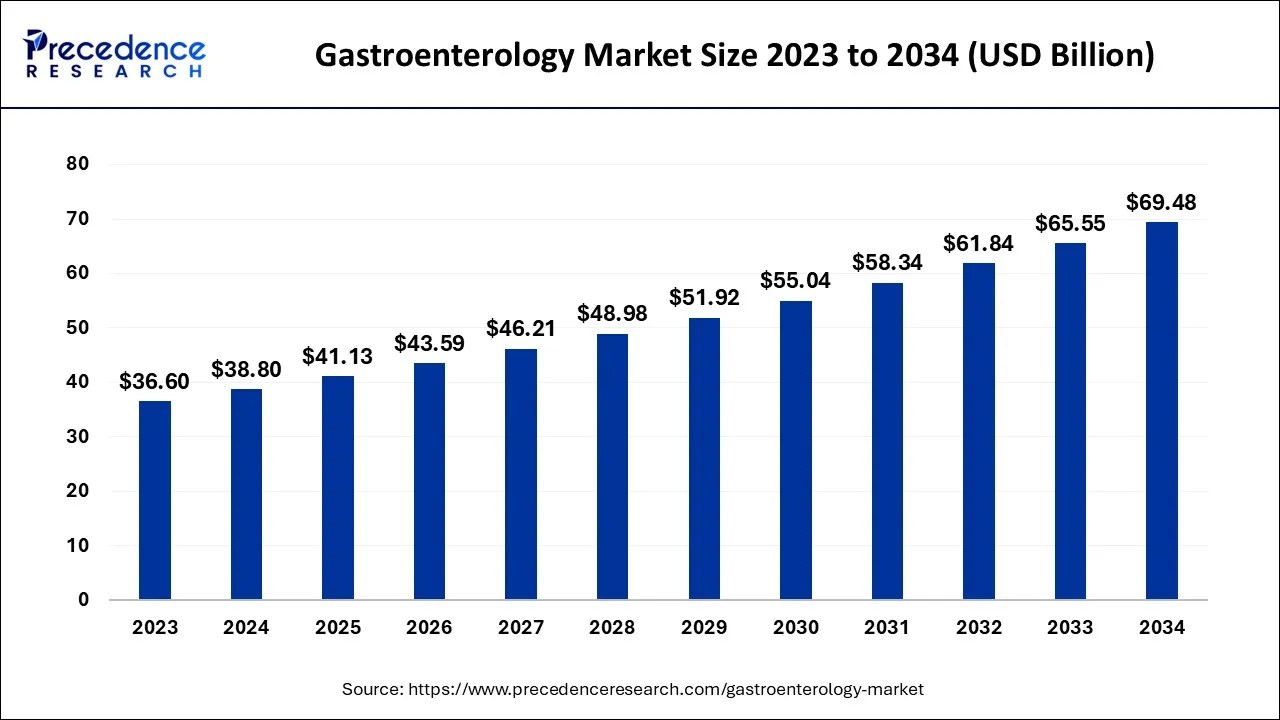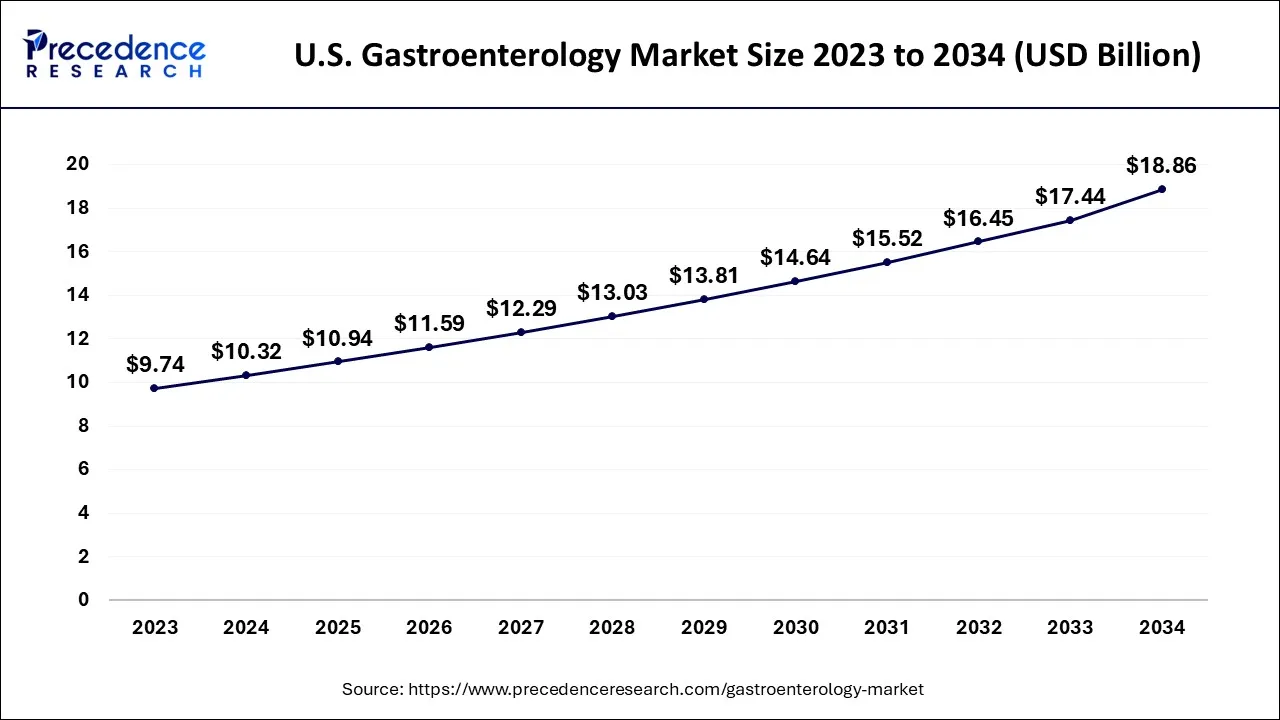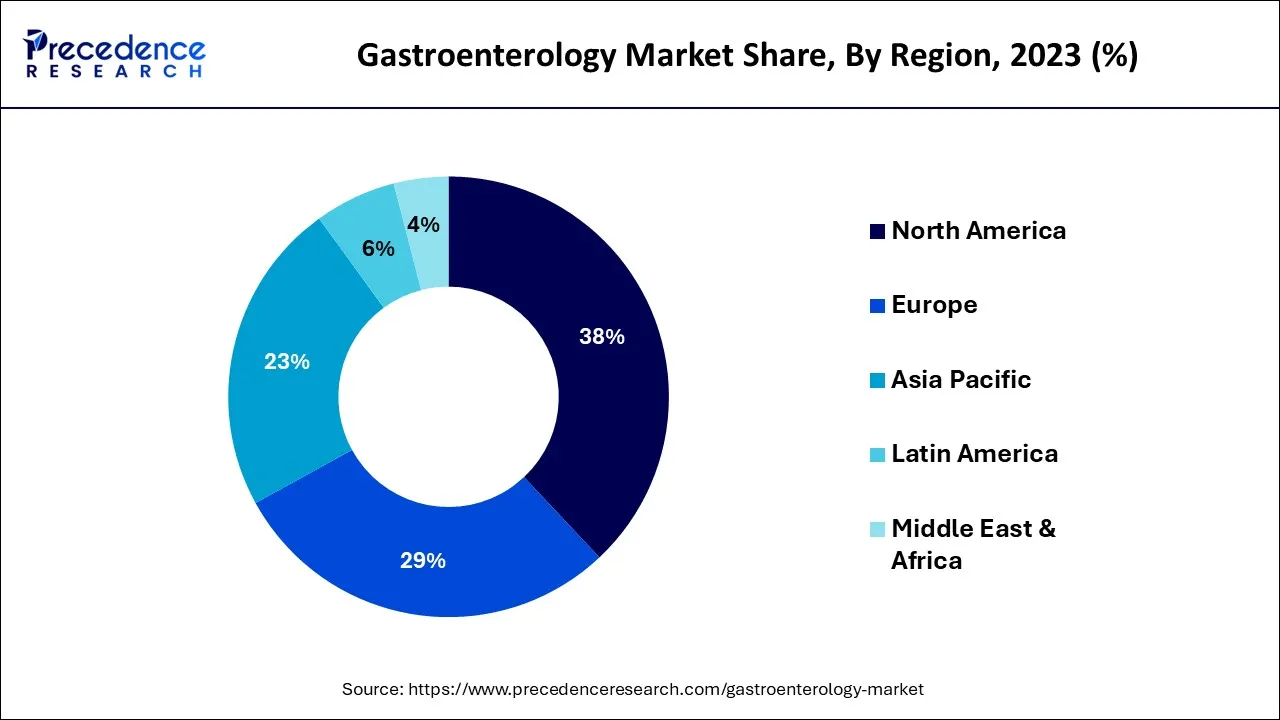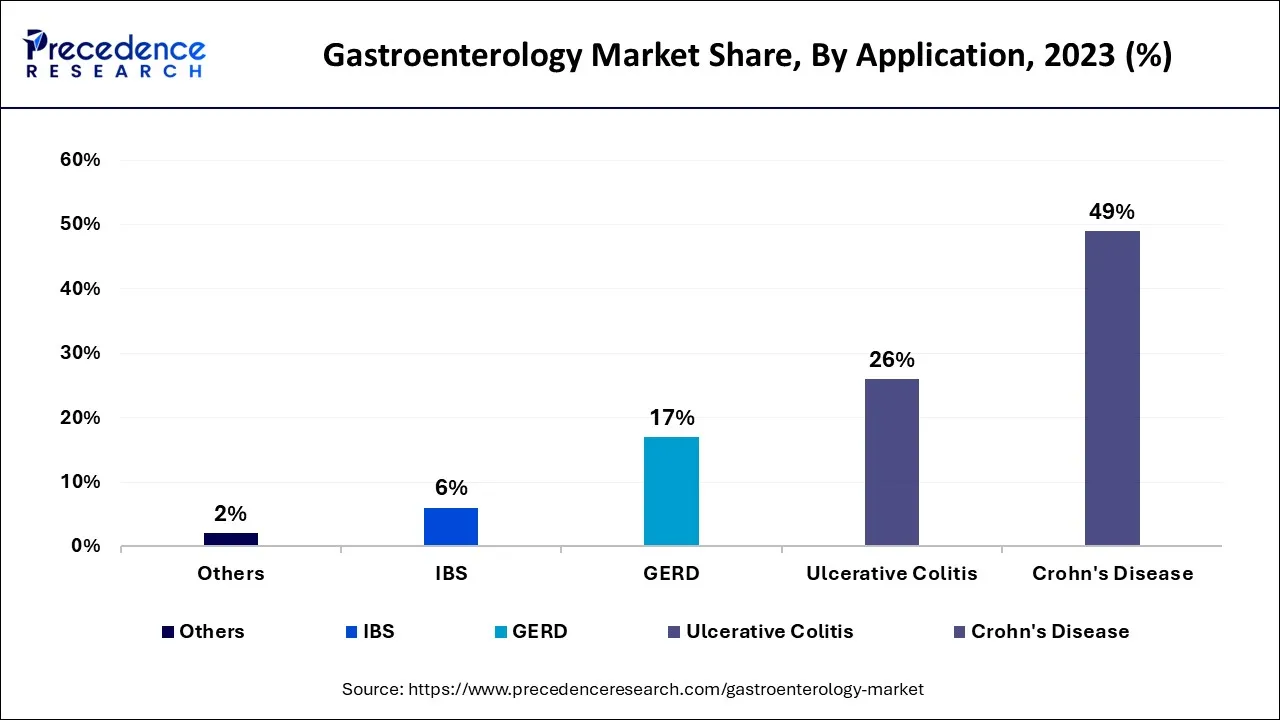July 2024
The global gastroenterology market size accounted for USD 38.80 billion in 2024, grew to USD 41.13 billion in 2025, and is expected to be worth around USD 69.483 billion by 2034, poised to grow at a CAGR of 6% between 2024 and 2034. The North America gastroenterology market size is predicted to increase from USD 14.74 billion in 2024 and is estimated to grow at the fastest CAGR of 6.14% during the forecast year.
The global gastroenterology market size is expected to be valued at USD 38.80 billion in 2024 and is anticipated to reach around USD 69.48 billion by 2034, expanding at a CAGR of 6% over the forecast period from 2024 to 2034.

The U.S. gastroenterology market size is exhibited at USD 10.32 billion in 2024 and is projected to be worth around USD 18.86 billion by 2034, growing at a CAGR of 6.21% from 2024 to 2034.

Technological advancements, an increase in gastrointestinal diseases, an increase in the number of geriatric and obese people, and an increase in research and development activities with the presence of major market players are some of the factors propelling market growth in the North American region.
Patients with co-morbid diseases, those who have impaired immune systems, and those who are malnourished and immunosuppressed have been shown to experience more severe COVID-19 infections. Crohn's disease and ulcerative colitis are both intestinal and extraintestinal manifestations of the chronic remitting and relapsing condition known as inflammatory bowel disease (IBD). Due to their frequent malnutrition and use of immunosuppressive drugs, people with inflammatory bowel disease (IBD) may be significantly more likely to get COVID-19 infection.

Market Overview
Gastrointestinal disorders are gastrointestinal illnesses that affect the colon, small and large intestines, and the rectum. Irritable bowel syndrome, peptic ulcer diseases, and constipation make up most of the problems. These are all characterized by symptoms like discomfort, bloating, diarrhea, nausea, and vomiting. The term "gastrointestinal therapies" refers to a class of medications that includes the following: Prilosec, Aciphex, Afinitor, Akynzeo, and Akynzeo.
The primary reasons propelling market expansion include expanding geriatric population, geriatric occurrences, overcrowding in the hospital outpatient department (HOPD), and rising demand for ambulatory treatments to minimize irrational hospitalization costs.
The market will grow in size during the projected period as a result of factors such as an increase in chronic diseases, a growth in the older population, unhealthy lifestyles, and an increase in the number of surgeries in the world.
The rising incidence of gastrointestinal disorders brought on by unhealthful eating patterns, the expansion of clinical studies with reliable findings, rising healthcare costs, and the rise in the elderly population are the main drivers of the gastroenterology market. But it's anticipated that the market will not grow as quickly as it may due to drug side effects and strict regulatory rules for drug approval.
In the near future, the gastroenterology industry will experience significant demand due to rising demand for self-medication and regenerative medicines, as well as several patient support programs implemented in emerging nations. Hospital patient loads have increased as a result of an increase in surgical operations, particularly small inpatient surgeries such as minor joint repair, abdominal hernia repair, gall bladder removal, cataract surgery, and other treatments. One of the main forces fueling the market's expansion is the increasing number of patients.
| Report Coverage | Details |
| Market Size in 2024 | USD 38.80 Billion |
| Market Size by 2034 | USD 69.48 Billion |
| Growth Rate from 2024 to 2034 | CAGR of 6% |
| Largest Market | North America |
| Base Year | 2023 |
| Forecast Period | 2024 to 2034 |
| Segments Covered | By Type, By Distribution Channel, By Application and By Route of Administration |
| Regions Covered | North America, Europe, Asia-Pacific, Latin America and Middle East & Africa |
The growing size and quantity of investments made in the healthcare system by governments and commercial companies of different countries are one of the primary drivers fueling the market's growth. The rapid economic development and the rising expense of healthcare would give more developing nations better access to high-quality care. Governments from several countries are attempting to improve residents' access to high-quality medical care and increase payment choices.
Additionally, pharmaceutical and biotechnology businesses are focusing more on R&D to find and create new medications for treating gastrointestinal illnesses, expanding their product pipeline. Additionally, the global increase in drug development for gastrointestinal illnesses is anticipated to contribute to the growth.
The market's expansion is constrained by the increase in healthcare costs. In addition, the market's expansion is constrained by the lack of access to medical services and treatments. Among inflammatory diseases, chronic gastritis is quite frequent. In many patients, the inflammatory stomach mucosa exhibits a tendency to atrophize over time (atrophic gastritis). Gastritis typically lasts a lifetime, and patients with autoimmune chronic corpus gastritis have very low chances of spontaneous recovery.
The Helicobacter pylori bacterium has been linked to gastritis. Gastric secretory processes, such as pepsin, gastric acid secretion, and gastrin, are hampered by inflammation and atrophy of the gastric mucosa. Therefore, it is anticipated that the gastroenterology field will suffer from the lack of effective and long-lasting treatments for gastrointestinal diseases.
The market will rise in the future as technologically sophisticated surgical techniques like minimally invasive operations become more commonplace, and as patients come to accept and become more aware of these procedures being provided in ambulatory facilities. This represents a significant prospective growth opportunity for the market during the anticipated term.
The market's simple access to medications to treat ulcerative colitis can be credited with the segment's expansion. The strong clinical urgency to stop the spread of ulcerative colitis is another factor contributing to the segment's expected rapid growth. Due to the poor prognosis and use of harmful foods, there is a great likelihood that the condition will return.
In Japan, there were over 180,000 people with ulcerative colitis, according to a study by Shinji Okabayashi et al. that was published in the Journal of the Anus, Rectum, and Colon in January 2020. Additionally, it has been noted that in newly industrialized areas of Latin America, ulcerative colitis (UC) incidence and prevalence are increasing.
The incidence and prevalence of ulcerative colitis (UC) in Latin America were 0.04 to 8.00/100,000 and 0.23 to 76.1/100,000, respectively, according to a study by Paulo Gustavo Kotze et al. that was published in Therapeutic Advances in Gastroenterology Journal in July 2020. As a result, studies and research indicate that the prevalence and incidence of Ulcerative Colitis are rising, which is driving demand for the market.
Growing R&D initiatives are also accelerating market expansion. There are over 245 current clinical studies for ulcerative colitis in various stages of development, according to the National Clinical Trials (NCT) registry as of May 2021. With the success of this research, ulcerative colitis patients might anticipate new, efficient treatments in the upcoming years.
The gastroenterology market is divided into branded and generic segments based on type. In terms of revenue, the branded segment led the gastroenterology market in 2023 owing to the good commercial performance of branded gastrointestinal products, the investigational pipeline's promising candidates combined with the high costs, and the market exclusivity. Additionally, it is estimated that the category will expand during the projected period due to the increasing regulatory approvals of branded pharmaceuticals.
The gastroenterology market is divided into hospital pharmacies, retail pharmacies, and online pharmacies according to the distribution channel. In 2023, the market for gastroenterology saw a significant revenue share for the online pharmacies industry. This is a result of rising online pharmacy trends, increased internet usage, and the numerous discounts provided by online pharma players. Additionally, the market sector is anticipated to develop during the anticipated period due to the rise in telemedicine adoption that occurred during the pandemic and continues to grow even after COVID-19.
The gastroenterology market is divided into categories based on application, including Crohn's disease, ulcerative colitis, GERD, IBS, and others. In terms of revenue share, the gastroenterology market's Crohn's disease sector led the way in 2023.

This is because there have been more cases of Crohn's disease (CD) over the past five decades, more novel drugs are being approved for CD, and there are more diagnostic options for the disease, such as imaging modalities or serological markers, which are expected to boost the market for CD during the forecasted period.
The gastroenterology market is segmented into oral, injectable, and other segments based on the route of administration. In the gastroenterology market in 2023, the injectables segment accounted for the largest revenue share. The elements driving the market's expansion include higher pricing, quick onset of action, better bioavailability, and a lower likelihood of first-pass metabolism in the case of injectable pharmaceuticals, as well as the higher acceptance rate of biological drugs.
By Type
By Distribution Channel
By Application
By Route of Administration
By Geography
For inquiries regarding discounts, bulk purchases, or customization requests, please contact us at sales@precedenceresearch.com
No cookie-cutter, only authentic analysis – take the 1st step to become a Precedence Research client
July 2024
June 2024